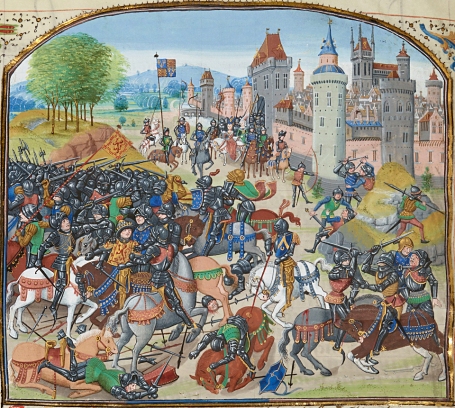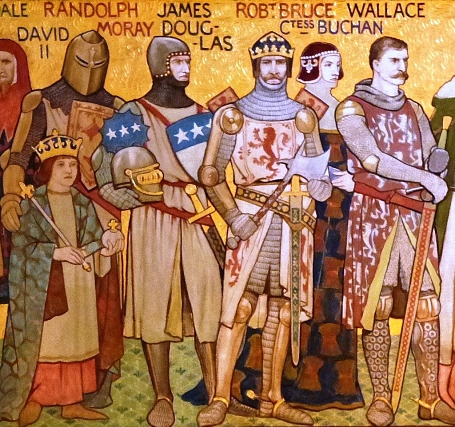The Life and Heroick Actions of the Renoun'd Sir William Wallace,
General and Governour of Scotland
by William Hamilton of Gilbertfield
Synopsis (Continued)
Wallace orders his men to besiege the castle at Dundee, which falls to their command in a short time. During the siege Sir Aymer Vallance has fled in "pannick fear" with all his goods and gear. He returns to England, where he spreads the news of Wallace's deeds.
King Edward sends Kirkingham and Earl Warenne with a large army of horse and foot soldiers to attack Scotland. Earl Patrick meets up with them at the Tweed. The English army, now numbering sixty thousand men, marches toward Stirling Bridge, besieging Stirling Castle along the way. Wallace, being informed of the English movement, leaves two thousand men behind to hold the castle at Dundee and marches the rest of his army south.
Stopping at St. Johnston for the night, Wallace consults with Sir John Graham and they agree that even though the English outnumber them, they should fight them at Stirling Bridge. Wallace sends Jop with a message to the English that they will fight on "Tuesday next."
By Saturday the Scots have arrived at Stirling Bridge, a broad wooden bridge that spans the Firth of Forth. Wallace assigns a watch, then sets a carpenter named John Wright to work sabotaging the bridge.
The day of the battle arrives with the Scots positioned in a field on the far side of the bridge. Kirkingham leads the English vanguard with twenty thousand men; De Warenne follows with thirty thousand; the Scots number nine thousand. As Kirkingham's men cross the bridge, Wallace's men advance on them; as De Warrenne's men are crossing, Wallace takes a horn from Jop, blows a signal, and the sabotaged bridge collapses, dropping men and horses into the river.
Wallace's men attack Kirkingham's twenty thousand; Wallace kills Kirkingham. The English, seeing their commander dead, attempt to flee; seven thousand drown in the river.
When De Warrenne's men see that the battle is lost, they flee as well, guided by Cospatrick, heading toward Dunbar. Wallace and Graham pursue, meeting up with Ramsay, Boyd, Richard of Lundie, Adam of Riccarton and Earl Malcolm with three hundred cavalry at Haddington. By this time DeWarrenne and Cospatrick have arrived safely at Dunbar. Wallace stays at Haddington that night, then marches back to Stirling in the morning.
Wallace is named Scots Warden (Guardian of Scotland) and takes an oath to protect the barons and the land with all his power. Sir John Mentieth, Earl of Arran, also takes an oath, saying he will stand by Wallace to defend the Scots crown. Wallace sets about organizing the realm, naming captains and sheriffs - some his family, some of "other blood" - to manage and govern the land. A time of peace prevails as, "Wallace much like a prince does rule and reign, waiting a time to get his lawful King from Edward, who kept him in London town, most wrongfully from his own righteous crown."
The ballad, The Life and Heroick Actions of the Renoun'd Sir William Wallace, General and Governour of Scotland, by William Hamilton of Gilbertfield, 1722, is in the public domain.

The Kingdom of England and the Kingdom of Scotland fought dozens of battles with each other. They fought typically over land, particularly Berwick-Upon-Tweed, and the Anglo-Scottish border frequently changed as a result. Read more at Wikipedia.

The First War of Scottish Independence was the initial chapter of engagements in a series of warring periods between English and Scottish forces lasting from the invasion by England in 1296 ... Read more at Wikipedia.